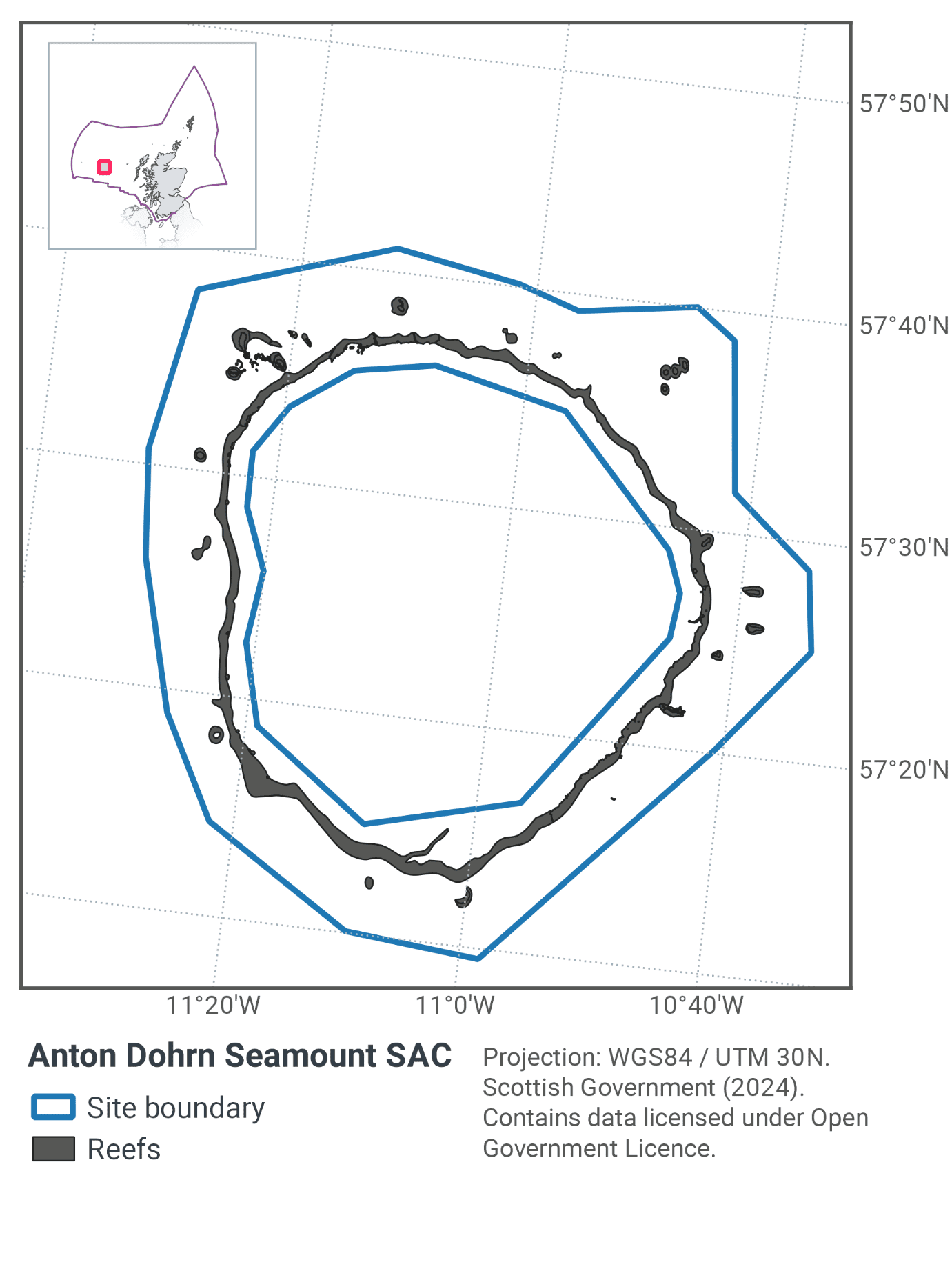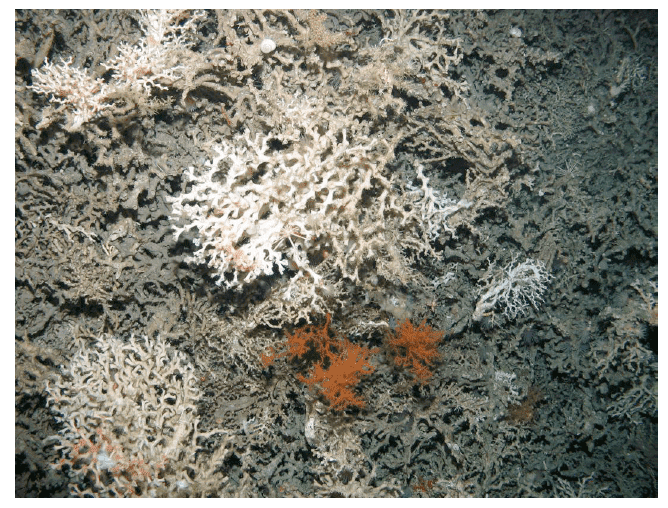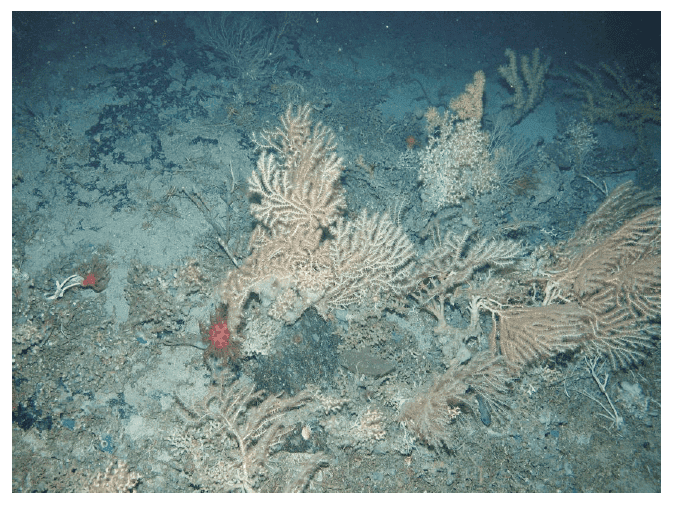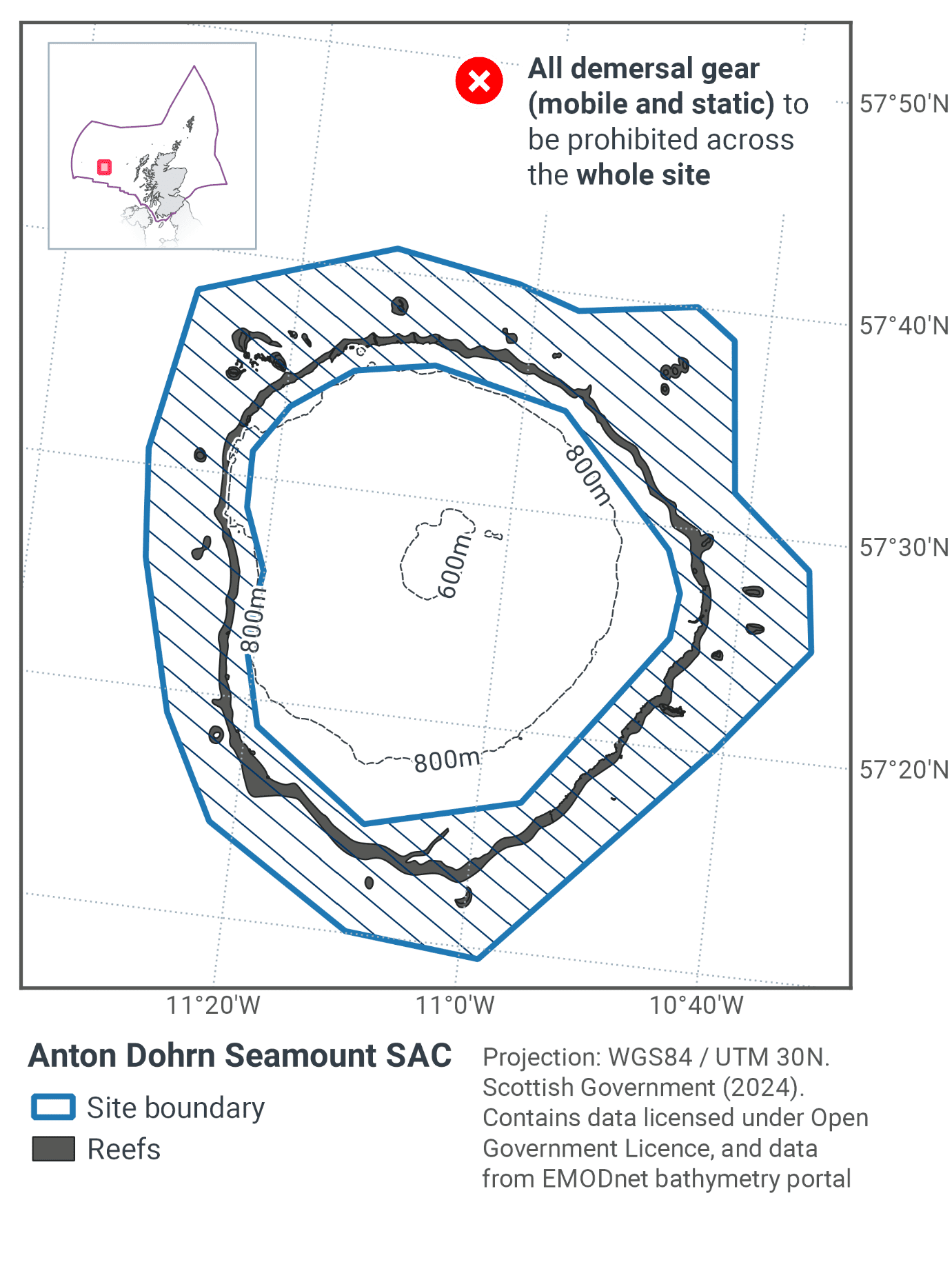Fisheries Management Measures within Scottish Offshore Marine Protected Areas (MPAs) - Site Proposal Document
This document describes the process, justification and evidence used to develop site specific management measures. It outlines key information for each site including their features, and risks of potential pressures.
17. Anton Dohrn Seamount SAC
17.1 Description and background
Anton Dohrn Seamount is located to the west of Scotland, as shown in Figure 42, about 200 km from the Outer Hebrides in the Rockall Trough, a deep water channel in the North-east Atlantic. This SAC overlaps the West of Scotland MPA designated in September 2020, The seamount is a former volcano, roughly circular in shape, and was last active 40 – 70 million years ago. The area of the SAC is 1,429 km2. The site contains approximately 128 km2 of bedrock, stony and biogenic reef sub-types of Annex I reef as shown in Figure 43.
The top is fairly uniform in depth (at 1,100 m) and is surrounded by steep cliff slopes extending down towards a moat at ~2,400 m water depth. The seamount is approximately 1,800 m high from the deepest point of the moat to the crest, and about 40 km in diameter (Long et al., 2010). On the lower flanks, parasitic cones occur that were formed when volcanic material erupted from lateral fractures rather than the central vent.
The upper regions of the seamount flanks are bedrock reef grading to stony reef on the lower flanks. These habitats support assemblages of sea cucumbers, brittlestars, cup corals and sponges. At the base of the seamount flanks, bedrock and stony reef outcrop on ridges, extending radially from the centre of the seamount and on the parasitic cones.
In places there are dense aggregations of sea whips (or sea fans) and other corals, in communities known as ‘coral gardens’ (Figure 43b). Also present is biogenic reef formed from Lophelia pertusa and Solenosmilia variabilis cold-water corals (Figure 43a). This structurally complex habitat supports a diverse and unique range of fauna, including black corals, sea whips, soft corals and stony corals.
Further information can be found in the Site Information Centre.

17.2 Site Features
The Anton Dohrn Seamount SAC is designated for the following protected features:
- Stony, bedrock and biogenic reefs (Annex I Reefs).
Anton Dohrn Seamount is located in the Rockall Trough and Bank Regional Sea and represents hard bedrock reef of low topographic-complexity, stony reef, and biogenic Lophelia Pertusa and Solenosmilia variabilis reef in the deep circalittoral to bathyal zone and dense aggregations of sea whips (or sea fans) and other corals form ‘coral garden’ communities. It therefore makes a contribution to the UK Network for Annex I reef habitat (H1170). As OSPAR Threatened and/or Declining habitats, this SAC also makes a contribution to the OSPAR network and furthering recovery of these habitats.


Figure 43. Examples of Annex I Reef feature and associated fauna within the Anton Dohrn Seamount SAC- a) dead sediment in-filled Lophelia pertusa framework on a mound feature with live L. pertusa and Madrepora oculata cold-water corals growing on the coral debris; b) Coral garden habitat on a parasitic cone feature with Lophelia pertusa, gorgonians, antipatharians and abundant associated fauna (©JNCC).
17.3 Site Boundary
The site boundary for Anton Dohrn Seamount was defined using the JNCC marine SAC boundary definition guidelines (JNCC, 2012a). The boundary encloses the minimum area necessary to ensure protection of the Annex I habitat. The boundary has been drawn in a ring shape that incorporates the Annex I habitats but excludes the central summit of the seamount. As the summit mostly comprises sands and gravels it was removed to reduce the area of ‘non-interest-feature’ included within the site boundary.
A buffer of 2,000 m has been applied at the summit edge, and 4,000 m at the foot of the seamount slope. These represent two times the water depth at the respective location.
17.4 Conservation objectives
JNCC’s view on the overall condition of the site’s qualifying feature is that it is in unfavourable condition and therefore needs to be restored to favourable condition.
The conservation objective for the Anton Dohrn Seamount SAC are for the feature to be in favourable condition thus ensuring site integrity in the long term and contribution to Favourable Conservation Status of Annex I Reefs.
This contribution would be achieved by maintaining or restoring, subject to natural change:
- The extent and distribution of the qualifying habitat in the site;
- The structure and function of the qualifying habitat in the site; and
- The supporting processes on which the qualifying habitat relies.
The full conservation advice documents can be found on the JNCC website. This includes the formal conservation advice for the site, background information and the full conservation objectives.
17.5 Pressure from demersal mobile fishing gear
Whilst it is unlikely that demersal mobile gear can affect the long-term natural distribution of bedrock and stony reef features, there is evidence to indicate that the use of demersal mobile gears can impact the structure and function of the habitat and the long term survival of its associated species.
The animal communities found on bedrock and stony reefs on seamounts tend to be composed of erect and fragile species that are sensitive to physical disturbance, particularly deep-sea stony corals, gorgonians and black corals, sea anemones, hydroids and sponges (Clark & Tittensor, 2010; Clark et al., 2010; Long et al., 2010) The use of mobile fishing gears is likely to cause damage or death of fragile, erect species, such as sponges and corals (Freese et al., 1999; Løkkeborg, 2005). Other species such as hydroids, anemones, bryozoans, tunicates and echinoderms may also be vulnerable (McConnaughey et al., 2000; Sewell & Hiscock, 2005). Where fragile, slow growing species occur, even low levels of fishing have the potential to change the structure and function of the habitats and may result in the loss of some characteristic species. Recovery from such damage is estimated to be measured on a decadal scale, depending on the environmental conditions (Clark et al., 2010; ICES, 2010).
Demersal mobile gears reduce the long-term natural distribution of cold-water coral (biogenic reef) features, as well as impacting the structure and function of the habitat and the long term survival of its associated species. The passage of mobile fishing gear may increase mortality of the coral by crushing, burying or wounding corals, increasing susceptibility to infection and epifaunal recruitment that may eventually smother corals (Fosså et al., 2002).
The passing of a heavy trawl reduces the three-dimensional structure of the coral to rubble, decreasing the complexity of the habitat with impacts on the associated community composition (Koslow et al., 2001; Fosså et al., 2002). Indirect impacts on cold water coral reefs from trawling are from increased levels of suspended particles in the water column causing smothering and polyp mortality (Larsson & Purser, 2011).
Given the slow growth rate of the reefs, they may take centuries to recover from damage, if at all (ICES, 2010).
17.6 Pressure from demersal static fishing gear
No studies providing evidence of the effects of demersal static gear on bedrock and stony reef on seamounts have been found, however impacts occurring on comparable vulnerable habitats and species, such as sponges and corals in Scottish waters are applicable (Muñoz et al., 2010). Demersal static gears are likely to reduce the long-term natural distribution of cold-water coral (biogenic reef) features, as well as impacting the structure and function of the habitat and the long-term survival of its associated species. The impacts are considered to be lower than for mobile gear types (Pham et al., 2014), however impacts to habitats and biota may occur during certain conditions. For example, hooks, lines, nets and ropes entangle corals and may pluck them during hauling (Grehan et al., 2004; ICES, 2010, Sampaio et al., 2012). Physical damage to the seabed has been observed which may be caused by dragged anchors (Grehan et al., 2004; ICES, 2010). The individual impact of a single fishing operation may be slight but cumulative damage can be significant. Given the slow growth rate of the reefs, they may take centuries to recover from damage, if at all (ICES, 2010).
17.7 Levels of fisheries management considered
Table 28 provides a summary of the management advice set out against the various options that have been considered.
Table 28. Summary of fisheries management advice for Anton Dohrn Seamount SAC
Fisheries management options considered for demersal mobile gear
No additional management: The conservation objectives for biogenic reef would not be met. There is a significant risk of not achieving the conservation objectives for the bedrock and stony reef features.
Reduce / limit pressures: This level of management would reduce the risk of not achieving the conservation objectives for the reef feature. Appropriate management could include exclusion of demersal mobile gears over the main areas of bedrock and stony reef and all known areas of biogenic reef, allowing fishing to continue in fishable areas around the features. It is possible that these areas may contain some very small areas of unknown bedrock and stony reef and there would therefore be a risk of localised damage to the structure and function of reef communities in these areas. The location of areas to be covered by management restrictions would include a buffer zone to reduce any risk of accidental contact with the feature.
Remove / avoid pressures: This level of management would reduce the risk of not achieving the conservation objectives for the reef feature within the site boundary to the lowest possible levels.
Fisheries management options considered for demersal static gear
No additional management: The conservation objectives for biogenic reef would not be met under this level of management. There is a risk of not achieving the conservation objectives for the bedrock and stony reef features.
Reduce / limit pressures: This level of management would reduce the risk of not achieving the conservation objectives for the reef feature. Appropriate management could include closure of the known extent of the biogenic reef feature within the site. However, a risk of impact with patches of feature not identified during survey would remain. The location of areas to be covered by management restrictions would include a buffer zone based on fishing warp length to depth ratio, to reduce any risk of accidental contact with the feature.
Remove / avoid pressures: This level of management would reduce the risk of not achieving the conservation objectives for the reef feature within the site boundary to the lowest possible levels.
17.8 Proposed fisheries management and rationale
Table 29 and Figure 44 provide details of the proposed management option and further explanation is provided below.
Protected feature |
Gear type |
Proposed management |
Measures |
|---|---|---|---|
Stony, bedrock and biogenic reef |
Demersal mobile |
Remove / avoid pressures |
Prohibit all demersal mobile gears from the SAC |
Demersal static |
Remove / avoid pressures |
Prohibit all demersal static gears from the SAC |
The presence of biogenic reef with the site means that the measures need to manage both demersal mobile and static fishing gears. These measures will help improve the conservation status of Annex I reef in the Atlantic marine biogeographic region.
In addition the measures will also contribute to the recovery of coral gardens and VME Lophelia Pertusa reefs. Both of these are listed by OSPAR as Threatened and/or Declining habitat in OSPAR region V. They should also further progress towards Good Environmental Status in the Celtic Seas, particularly in relation to Descriptors 1 (biological diversity) and 6 (sea-floor integrity).

Figure 44. Anton Dohrn Seamount SAC proposed full site management measures.
Contact
Email: marine_biodiversity@gov.scot
There is a problem
Thanks for your feedback